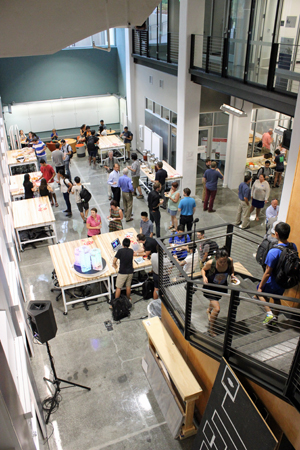At the Duke Global Health Institute, their academic base is relatively small; only 375 students have completed global health programs at Duke since 2008. But their partnerships span much farther than the Duke campus.

Randall Kramer (left) is Deputy Director of the Duke Global Health Institute and a Professor of Resource and Environmental Economics in the Nicholas School
Malaria researcher Randall Kramer, the Deputy Director of the Duke Global Health Institute, maintains a network of Priority Partnership Locations (PPLs), so that Duke students can have sustained learning experiences through fieldwork. The network puts Duke’s global health students into communities where these PPLs are based.
Kramer’s own research is on the environmental economics that dictate the success of global initiatives to fight malaria. Kramer highlighted a two-prong approach that he has found to be highly effective in preventing the spread of malaria. The first aspect is prevention; if the disease-carrying mosquitoes cannot reach a host, humans cannot become infected with malaria. Techniques like the employment of bed nets and insecticide spraying inside houses of rural African and Asian villages have proven to be very effective in the prevention of infection. However, these methods are not 100% effective so some infections will occur even when there is excellent prevention activity.

Kramer and colleagues have worked with universities and government officials in Tanzania and Uganda to assess malaria control strategies.
The second aspect of fighting malaria is in treatment after infection. In the United States, infections are easily treatable with medications, but in low-income rural communities, one of the biggest problems is the lack of trained medical workers to diagnose malaria and administer medication. There are some drugs that have been very effective in eliminating the malaria parasite once introduced to the human body, , but there still remains a struggle with regard to drug availability and lack of human resources.
Kramer is pleased with the changes in malaria treatment and prevention over the past twenty years, during which malaria related deaths in the world have dropped significantly. But he said there is still a long ways to go before malaria no longer remains a serious health concern. One of the biggest problems that Kramer identified has been the lack of coordination between organizations targeting malaria prevention and treatment. He praised the current organizations in their efforts and funding to help the cause, but suggested that if the organizations were better coordinated, their efforts would save even more lives.
One organization he identified as a great contributor to ending malaria was the Bill and Melinda Gates Foundation, which has poured millions of dollars into research towards a vaccine for malaria. Kramer is hopeful that nearly complete control of malaria can be achieved in coming decades. He also believes that helping Duke students gain experience in low resource settings will increase their understanding of the global health challenges and solutions.
 Guest Post by Ben Fawcett, a senior at the North Carolina School of Science and Math
Guest Post by Ben Fawcett, a senior at the North Carolina School of Science and Math
























